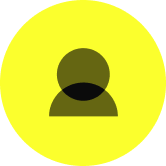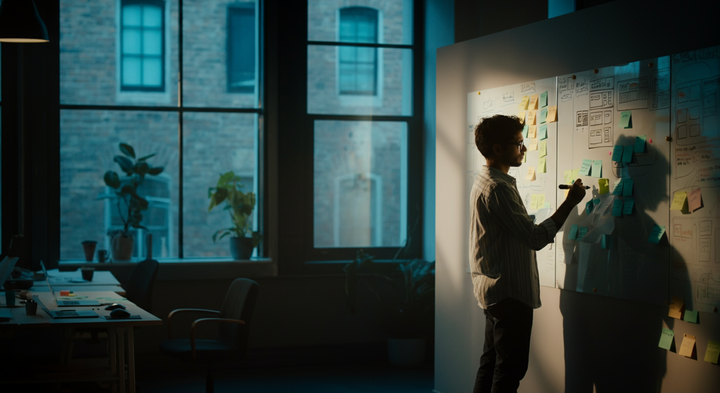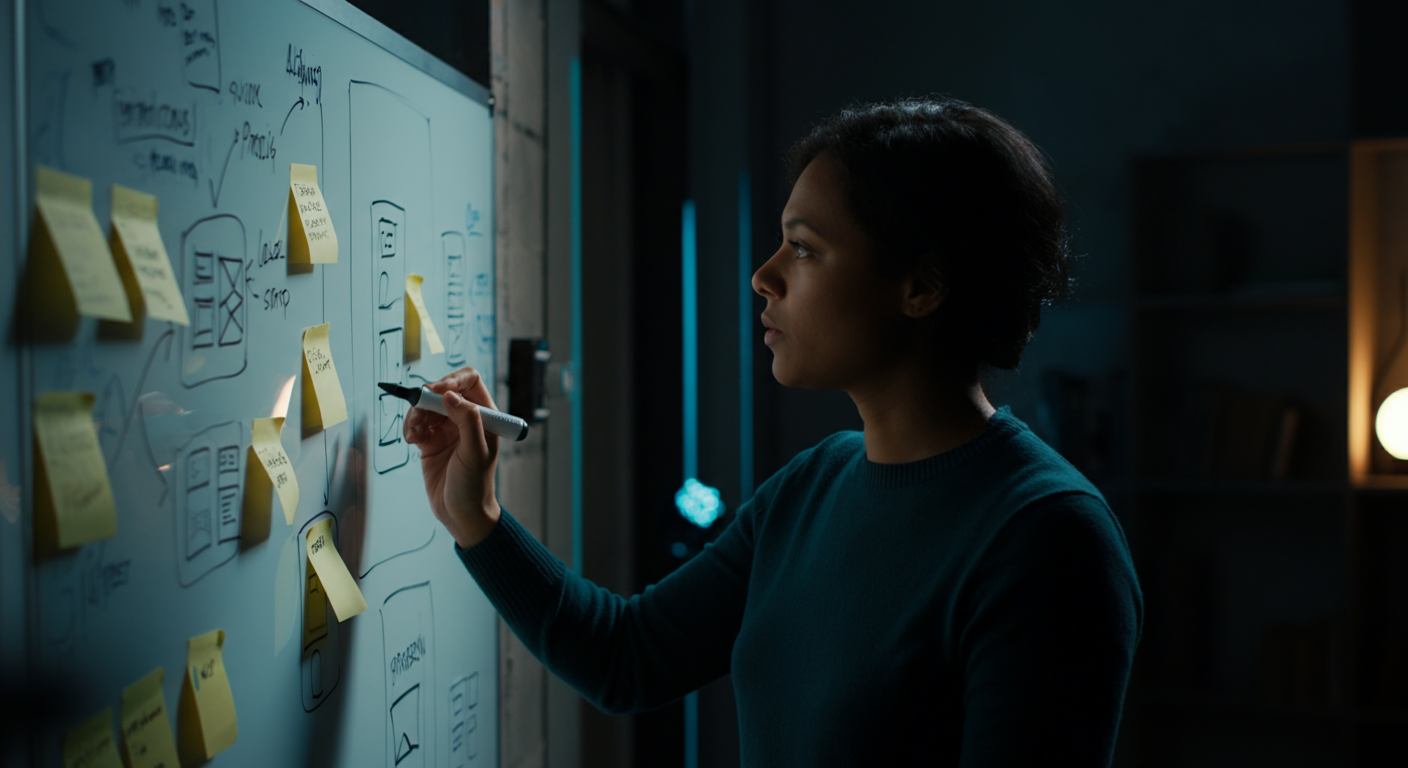Understanding the Product Designer Role: A Day in the Life
Product designers are crucial in creating user-friendly and compelling digital products that meet business goals. In this article, we’ll explore the world of product design and the critical responsibilities of a product designer.
What you will learn:
- The essential skills needed to succeed as a product designer
- The day-to-day tasks and responsibilities of a product designer
- Insights into the product design career path and its growth potential
Read on to discover what it takes to thrive in this exciting and dynamic field.
This article is brought to you by Experience Haus – London’s leading provider of immersive, real-world courses in design, strategy, marketing and tech. Whether you’re looking to launch a new career in UX/UI design, upskill in product management, or explore the latest in AI, Experience Haus offers expert-led training to help you succeed. Explore our range of UX/UI courses to open up a world of exciting career opportunities.
Understanding the Product Designer Role
A product designer’s job description typically includes responsibilities such as empathy, user research, prototyping, visualisation and communication, covering various aspects like UX design, UI design, interaction design and information architecture.
They combine their understanding of user behaviour, market trends, and technical constraints to design functional and visually appealing products.
Product designers work closely with cross-functional teams, including UX researchers, UI designers, interaction designers, and product managers, to ensure the final product is user friendly and aligns with the company’s objectives.
The Importance of Product Designers
Product designers play a vital role in a product’s success. They are responsible for creating a seamless user experience that keeps users engaged and satisfied. Creating a functional user experience is crucial in product design, as it translates the product’s goal into an intuitive and efficient user experience, reducing friction points and improving page load speeds.
By understanding user needs and preferences, product designers can create products that solve real problems and meet market demands. Their work directly impacts a product’s usability, functionality and aesthetics, which can make or break its success in the market.
The Product Design Process
The product design typically consists of several key stages, including research, ideation, prototyping, testing, and implementation.
Each stage is crucial to the final product’s success and requires close collaboration between the product designer and other team members.
The process starts with a deep understanding of user needs and business goals, which informs the ideation stage, where potential solutions are explored. This stage often involves improving or enhancing existing products to suit the company’s business needs better.
Then, prototypes are created and tested with users to gather feedback and refine the design. Finally, the product is implemented and launched to the market.
The Product Designer’s Role in Each Stage
Throughout the product design process, the product designer plays a central role in ensuring that the product meets user needs and business goals. In the research stage, they work closely with UX researchers to gather insights into user behaviour and preferences while also considering business needs.
They collaborate with other designers and stakeholders to explore potential solutions and define the product vision during ideation. In the prototyping and testing stages, product designers create interactive prototypes and gather user feedback to refine the design.
Finally, they work with development teams to ensure the final product is implemented according to the design specifications.
Conducting User Research
User research is a critical component of the product design process, as it provides valuable insights into user needs, preferences, and behaviours.
By understanding the target audience and their pain points, product designers can create solutions that address real problems and provide value to users.
User research can take many forms, including interviews, surveys, usability testing, and analytics, each providing a unique perspective on user behaviour and preferences.
Gathering and Analysing User Feedback
Gathering user feedback is an ongoing process throughout the product design lifecycle. Product designers use various methods to collect feedback, such as usability testing, beta testing, and user surveys.
By analysing this feedback, designers can identify areas for improvement and make data-driven decisions to refine the product. It’s essential to approach user feedback with an open mind and a willingness to iterate based on the insights gained.
Defining Design Requirements
Product designers work closely with project managers to define the design requirements for a product. This collaboration ensures the design aligns with the project goals, timeline, and resources.
Project managers provide valuable input on the feasibility and scope of the design, while product designers contribute their expertise in user experience and visual design.
Defining Design Requirements
Defining design requirements is a crucial step in the product design process, as it sets the foundation for the entire project.
Product designers work with stakeholders to gather and prioritise requirements, considering user needs, business goals, and technical constraints.
Clear and well-defined design requirements help guide the design process and ensure the final product meets the desired outcomes.
Creating User Flows and Information Architecture
User flows are visual representations of a user’s steps to complete a specific task within a product.
Product designers create user flows to understand how users navigate the product and identify potential pain points or areas for improvement.
By mapping out user flows, designers can optimise the user experience and ensure the product is intuitive and easy to use.
Creating Information Architecture
Information architecture refers to the organisation and structure of content within a product. Product designers create information architecture to ensure users can easily find and access the necessary information.
This involves creating a clear information hierarchy, consistent labelling and navigation, and grouping related content. A well-designed information architecture can enhance the user experience and make the product more engaging and efficient.
Designing Visual Elements
Visual design is a critical aspect of product design, as it directly impacts how users perceive and interact with the product.
Product designers use visual design to create an engaging and memorable user experience, using elements such as colour, typography, and imagery to convey the brand’s personality and values.
Good visual design can make a product more attractive, credible, and user-friendly, increasing user satisfaction and engagement.
Visual Design Tools
Product designers use various visual design tools to create and refine a product’s visual elements. These tools range from sketching and wireframing software to more advanced graphic design programs like Adobe Illustrator and Sketch.
Visual design tools allow designers to experiment with different design concepts, create high-fidelity mockups, and collaborate with other team members. Mastering these tools is essential for product designers to bring their vision to life and create visually stunning products.
Prototyping and Testing
Prototyping is an essential part of the product design process. It allows designers to test and refine their ideas before committing to a final design.
Product designers create prototypes at various fidelity levels, from simple paper sketches to interactive digital mockups. Prototypes help designers communicate their vision to stakeholders, gather user feedback, and identify potential usability issues early in the design process.
Conducting User Testing
User testing is a crucial step in product design, providing valuable insights into how users interact with the product. Product designers conduct user testing sessions to observe users as they complete specific tasks, gather feedback, and identify areas for improvement.
User testing can be done at various stages of the design process, from early concept testing to pre-launch usability testing. By incorporating user feedback into the design, product designers can create more user-friendly, efficient, and engaging products.
Collaborating with Cross-Functional Teams
Product designers often work closely with UX designers to create a seamless and intuitive user experience. While product designers focus on the overall product vision and strategy, UX designers specialise in understanding user behaviour and creating user-centred designs.
They collaborate to conduct user research, create user flows and wireframes, and ensure that the product meets user needs and expectations.
Collaborating with UI Designers
Product designers collaborate with UI designers to create visually appealing and on-brand designs. UI designers specialise in creating a product’s visual elements, such as typography, colour schemes, and iconography.
They work closely with product designers to ensure the visual design aligns with the overall product vision and enhances the user experience. By collaborating with UI designers, product designers can create functional and visually stunning products.
Balancing Business Goals and User Needs
Product designers must clearly understand the business goals behind a product, as these goals ultimately guide the design decisions. Business goals include increasing revenue, acquiring new customers, or improving customer retention.
By aligning the product design with business objectives, product designers can create products that meet user needs and contribute to the company’s success.
Addressing User Needs
While business goals are essential, product designers must prioritise user needs in their design decisions. Users are the ultimate judges of a product’s success, and their satisfaction is crucial for long-term viability.
Product designers must balance business goals with user needs, finding solutions that benefit both the company and the end-users. This requires a deep understanding of user behaviour, preferences, and pain points and the ability to translate these insights into meaningful design decisions.
Continuously Iterating and Improving
Product design is an iterative process; continuous improvement is essential for successful product creation. As user needs and market demands evolve, product designers must be willing to adapt and refine their designs accordingly.
Iterating on a design allows designers to incorporate user feedback, address usability issues, and explore new opportunities for innovation. By embracing a continuous improvement mindset, product designers can create relevant and valuable products for users over time.
Incorporating User Feedback and Market Needs
Product designers must actively seek out and incorporate user feedback, and market needs to iterate and improve a product. This involves conducting regular user testing, analysing product metrics, and staying up-to-date with industry trends and best practices.
By listening to users and understanding the broader market context, product designers can identify areas for improvement and make data-driven decisions to optimise the product. This ongoing process of gathering insights, iterating on the design, and measuring results is crucial for creating products that continue to meet user needs and drive business success.
Frequently Asked Questions
What skills are needed to be a product designer?
Product designers need a combination of design skills (visual, interaction, and industrial design), technical skills, user research, project management, and communication skills. To create successful products, they must also understand user needs, consumer preferences, and business requirements.
What does a product designer do daily?
Product designers’ daily tasks include conducting user research, analysing data, creating wireframes and prototypes, collaborating with cross-functional teams, and presenting designs to stakeholders. They oversee the entire product development process, ensuring the final product meets user needs and business goals.
How many hours do designers work a day?
Most designers work a standard 8-hour day, but some may work extra hours to meet project deadlines or accommodate changes in project scope. The workload can vary depending on the company and industry.
Is product design a promising career?
Yes, product design is a promising career with growing demand, opportunities for growth, and the chance to work on diverse projects across various industries. With the right skills and passion, product designers can create innovative solutions that drive business success and positively impact users’ lives.
Conclusion
In summary, product design is a dynamic and rewarding career that requires a unique blend of skills, creativity, and user-centric thinking. As the demand for innovative and user-friendly products grows, product designers will play an increasingly crucial role in shaping the digital landscape.
By understanding the key responsibilities, daily tasks, and growth opportunities within this field, aspiring product designers can embark on a fulfilling career path that allows them to make a meaningful impact on the products and experiences that shape our world.
Advance Your Design Career with Experience Haus
Ready to advance your design skills? Experience Haus offers immersive courses and workshops in UX/UI design, product design, AI, and more. Led by industry experts, our real-world training helps both aspiring and experienced designers gain the skills and confidence needed to succeed.
Experience Haus courses feature:
- Live client projects to build your portfolio
- Small class sizes for personalised attention
- Flexible online and in-person formats in London
- Career support and an active alum community
Explore our upcoming courses in:
Ready to jumpstart your design career? Browse our complete course offerings and sign up today. Join our newsletter to stay updated on the latest courses, events, and industry insights.
Start your design journey with Experience Haus and open up a world of exciting career possibilities. We look forward to being part of your creative future.




